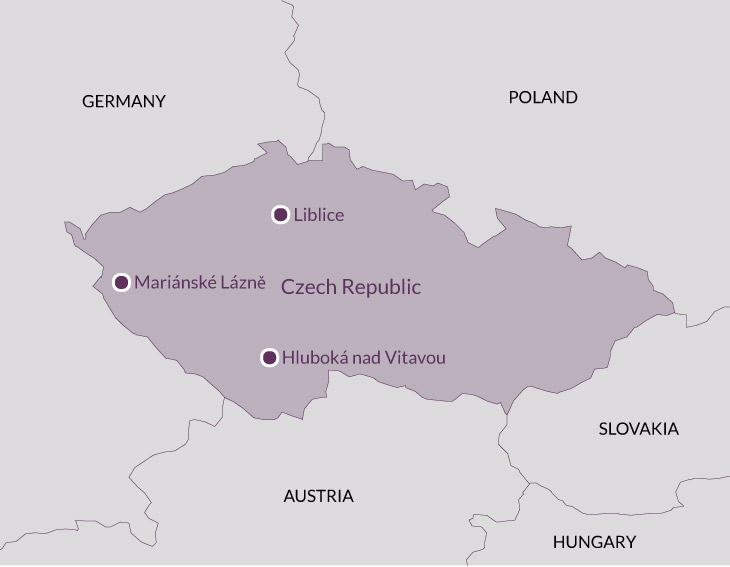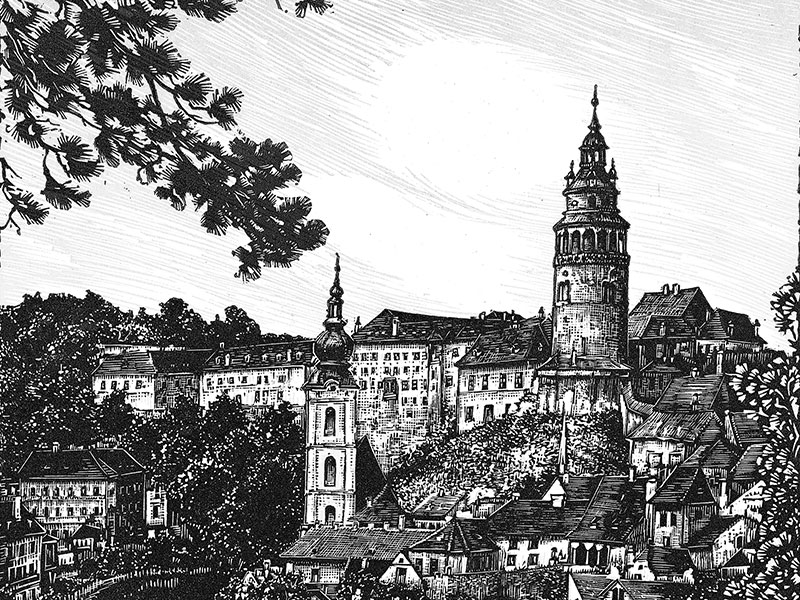Overview
Draw two lines across a map of Europe, from Inverness to Istanbul and from Málaga to Moscow: the place where they cross is Bohemia. The heart of Europe thus crudely determined turns out to be a region whose exact whereabouts and current political description may challenge more than a few of you, an ignorance not dispelled by association with a decorously dissolute lifestyle.
Yet there were times when Bohemia was a significant European power, enjoyed a thriving economy and marching in the vanguard of political, social and cultural developments. (In one of these expansionist moments, over three hundred years before A Winter’s Tale, it acquired a coast.) But Fate seems to have decreed that each rise was soon to be followed by a fall. The most recent was a double fall – dismemberment and desecration by the Nazis was followed by a forty-year incarceration behind the Iron Curtain.
Paradoxically, Communist rule helped to preserve a wonderful architectural patrimony, the most abundant in Central Europe. Ideologically inspired contempt for and neglect of its heritage was constrained by lack of means to modernise, rebuild or demolish (thanks to a baleful economic model), a mixture that acted like a mildly corrosive aspic: deterioration, but little destruction. But since the Velvet Revolution of 1989, a surge of restoration and rehabilitation has transformed both the architectural set pieces and the humbler buildings. The built environment and the art of Bohemia have never looked better.
There are towns with streets and squares with façades from every century from the fifteenth to the early twentieth; a remarkable variety of castles and country houses, most retaining fine furnishings and pictures; magnificent churches and abbeys, medieval and Baroque; distinctive works of art in excellent galleries.
And the landscape is enchanting, mostly gently hilly, sometimes rugged, much of it wooded interspersed with fertile fields of pasture or arable, large tracts surprisingly empty. The River Vltava is a recurring feature, cutting a curvaceous course from south to north, and so are the many small lakes, most formed in the Middle Ages for the cultivation of fish.
Day 1
Fly at c. 9.45am from London Heathrow to Prague. Drive to Zámek Mělník before settling in at a country house hotel near Liblice in time for an introductory talk before dinner. The next three nights are spent here.
Day 2
Kutná Hora, Kačina. In the Middle Ages, the silver mines at Kutná Hora made the city wealthy. Now a small provincial town of great charm, it possesses a wonderful cathedral, perhaps the greatest Gothic building in Central Europe, the creation sequentially of Bohemia’s two finest medieval architects. Set in a landscaped park, the country house at Kačina is a marvellous classical design of the early 19th century with a circular library, theatre, and a sequence of fine rooms. Overnight Liblice.
Day 3
Nelahozeves, Troja. Nelahozeves is a magnificent house of the mid-16th century, externally retaining the aspect of a fortress but internally embodying Italianate Renaissance elegance. Restituted to the Lobkowicz family, the furnishings and works of art are excellent. Dvořák’s birthplace museum is in the village. Built as a riverside retreat, Villa Troja is a fine 17th-century Italianate mansion with painted hall and delightful formal French garden. Overnight Liblice.
Day 4
Karlštejn, Tábor. Drive to South Bohemia via Karlštejn, built by Emperor Charles IV, whose reign (1346–78) saw Bohemia reach its apogee. A chapel embedded in the impregnable keep, with its walls of semi-precious stones, gilded vault and 130 panel paintings is the most opulent surviving mediaeval interior. Now a small country town, Tábor looms large in Bohemian history as the redoubt of the Hussites. The historic centre, an irregular ‘square’ with a Gothic town hall, is wonderfully preserved, First of three nights in Hluboká nad Vltavou.
Day 5
Hluboká, Český Krumlov. Summer home of the Schwarzenbergs, dominant dynasty of South Bohemia, the Gothic Revival mansion of Hluboká is sumptuously furnished. The adjacent regional art collection has good medieval and 20th-century Czech works. Clustered around a bend in the upper reaches of the Vltava, Český Krumlov is a highly picturesque little town. The hilltop castle was largely rebuilt in the 16th and 18th centuries; among its treasures are a hall painted with masked revellers, an excellently preserved theatre and a formal garden.
Day 6
Jindřichův Hradec, Třeboň. Jindřichův Hradec is a small, pretty town whose extensive aristocratic residence is notable for its Renaissance parts, in particular a beautiful rotunda. At the heart of a district of lakes formed in the Middle Ages to cultivate fish, Třeboň is another delightful town, still partly walled, home to the Neo-Gothic Schwarzenberg mausoleum.
Day 7
Kratochvíle, Plzeň. Secluded within a walled garden amid particularly lovely countryside, Kratochvíle is the finest Renaissance villa in the country. Continue to West Bohemia. The centre of the city of Plzeň adheres to its 13th-century grid plan; Gothic cathedral, the world’s third largest synagogue (1880s) and varied street frontages. Overnight Mariánské Lázně.
Day 8
Mariánské Lázně (Marienbad). For most of the 19th century and into the 20th, Marienbad was one of Europe’s most fashionable spas, with patronage from monarchs (Edward VII) to mavericks (Marx, Chopin, Wagner). White, yellow and ochre, from serene classicism to riotous ‘Renaissance’, the hotels and spas gather around a lovely landscaped park. Fly from Prague Airport, arriving Heathrow c. 6.15pm.
Price, per person
Two sharing: £3,170 or £3,010 without flights. Single occupancy: £3,390 or £3,230 without flights.
Included
Air travel (economy class) on British Airways flights (Airbus A320); travel by private coach; accommodation as described below; breakfasts, 4 lunches and 5 dinners with wine; admission charges for all museums and places visited; all tips for waiters, drivers and guides; all taxes; the services of the lecturer and local guide..
Accommodation
Hotel Château Liblice, near Liblice: 4-star hotel and conference centre converted from an 18th-cent. country house. Hotel Stekl in Hluboká nad Vltavou: a 4-star hotel converted from an auxiliary building belonging to the neighbouring mansion. Falkensteiner Hotel Grand MedSpa Marienbad: an Art Nouveau hotel in the centre of town. Single rooms are doubles for sole use throughout.
How strenuous?
There is quite a lot of walking on this tour, some of it up slopes or up steps. To be able to enjoy the tour it would be essential to manage daily walking and stair-climbing without any difficulties. Average distance by coach per day: 104 miles.
Are you fit enough to join the tour?
Group size
Between 10 and 22 participants.
Travel advice
Before booking, please refer to the FCDO website to ensure you are happy with the travel advice for the destination(s) you are visiting.

'This was my first tour with Martin Randall and I thoroughly enjoyed it.'
'This tour was a delight and a revelation.'
'The lecturer was an excellent and very expert leader; we could not have done better.'
